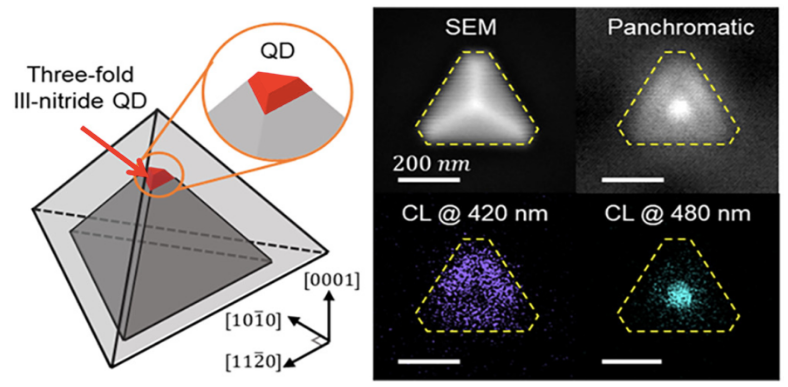Prof. Cho’s group at KAIST formed nitride semiconductor quantum dots using pyramidal-shaped three-dimensional nanostructures, and succeeded in controlling the triangular symmetry of the quantum dots. This results expected to contribute to the development of polarization-entangled photon pair emitting quantum light sources. The study was published on September 10, 2020 in Nano Letters (Control of the 3-Fold Symmetric Shape of Group III-Nitride Quantum Dots: Suppression of Fine-Structure Splitting., Nano Letters, 20, 8461-8468 (2020)).
Semiconductor quantum dots are widely studied as representative quantum light emitting devices that emit single photons at a desired moment. In particular, they are intriguing as quantum light sources in various quantum applications such as quantum optical communication, quantum computing, and quantum cryptography owing to the deterministic generation of single photons or entangled photon pairs.
Although an ideal quantum dot has in-plane symmetry, the self-assembled quantum dot growth method based on strain relaxation, which was mainly used in the past, has limitations in making an ideal quantum dot because of the randomness of the strain relaxation mechanism. Nitride semiconductors can maintain quantum properties even at room temperature, so they can in principle emit polarized entangled photon pairs. However, even if the symmetry of the quantum dots breaks a little, the phenomenon of fine-structure splitting occurs significantly, and the entanglement properties easily disappears. Therefore, to form an entangled photon pair emission quantum light source using nitride semiconductors, it is essential that controlling the position and symmetry in the fabrication stage.
The researchers succeeded in controlling the triangular symmetry of nitride semiconductor quantum dots for the first time by using a three-dimensional nano-pyramid structure and a self-limited growth method. In order to analyze the light emission of the formed nanostructures, the researchers used micro-photoluminescence and cathodoluminescence techniques with a spatial resolution of several nanometers. As a result, it was confirmed that single quantum dots were stably formed at the vertices of the triangular pyramid nanostructures.
“We have solved the problem of quantum dot asymmetricity by effectively controlling the semiconductor quantum dots,” Cho said. “We can use nitride semiconductor-based quantum dots that operate at room temperature to develop next-generation quantum light sources such as polarization-entangled photon-pair emission devices.”
This work was supported, in part, by the Samsung Science and Technology Foundation and the National Research Foundation of Korea.

Prof. Yong-Hoon Cho Department of Physics, KAIST
Homepage: http://qnp.kaist.ac.kr
E-mail: yhc@kaist.ac.kr






